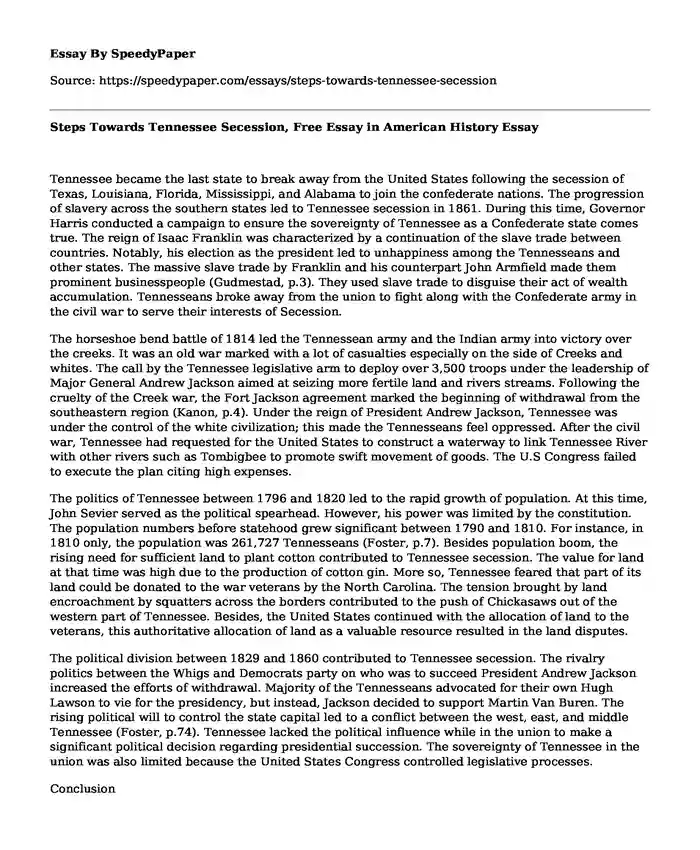
| Type of paper: | Essay |
| Categories: | American history |
| Pages: | 3 |
| Wordcount: | 683 words |
Tennessee became the last state to break away from the United States following the secession of Texas, Louisiana, Florida, Mississippi, and Alabama to join the confederate nations. The progression of slavery across the southern states led to Tennessee secession in 1861. During this time, Governor Harris conducted a campaign to ensure the sovereignty of Tennessee as a Confederate state comes true. The reign of Isaac Franklin was characterized by a continuation of the slave trade between countries. Notably, his election as the president led to unhappiness among the Tennesseans and other states. The massive slave trade by Franklin and his counterpart John Armfield made them prominent businesspeople (Gudmestad, p.3). They used slave trade to disguise their act of wealth accumulation. Tennesseans broke away from the union to fight along with the Confederate army in the civil war to serve their interests of Secession.
The horseshoe bend battle of 1814 led the Tennessean army and the Indian army into victory over the creeks. It was an old war marked with a lot of casualties especially on the side of Creeks and whites. The call by the Tennessee legislative arm to deploy over 3,500 troops under the leadership of Major General Andrew Jackson aimed at seizing more fertile land and rivers streams. Following the cruelty of the Creek war, the Fort Jackson agreement marked the beginning of withdrawal from the southeastern region (Kanon, p.4). Under the reign of President Andrew Jackson, Tennessee was under the control of the white civilization; this made the Tennesseans feel oppressed. After the civil war, Tennessee had requested for the United States to construct a waterway to link Tennessee River with other rivers such as Tombigbee to promote swift movement of goods. The U.S Congress failed to execute the plan citing high expenses.
The politics of Tennessee between 1796 and 1820 led to the rapid growth of population. At this time, John Sevier served as the political spearhead. However, his power was limited by the constitution. The population numbers before statehood grew significant between 1790 and 1810. For instance, in 1810 only, the population was 261,727 Tennesseans (Foster, p.7). Besides population boom, the rising need for sufficient land to plant cotton contributed to Tennessee secession. The value for land at that time was high due to the production of cotton gin. More so, Tennessee feared that part of its land could be donated to the war veterans by the North Carolina. The tension brought by land encroachment by squatters across the borders contributed to the push of Chickasaws out of the western part of Tennessee. Besides, the United States continued with the allocation of land to the veterans, this authoritative allocation of land as a valuable resource resulted in the land disputes.
The political division between 1829 and 1860 contributed to Tennessee secession. The rivalry politics between the Whigs and Democrats party on who was to succeed President Andrew Jackson increased the efforts of withdrawal. Majority of the Tennesseans advocated for their own Hugh Lawson to vie for the presidency, but instead, Jackson decided to support Martin Van Buren. The rising political will to control the state capital led to a conflict between the west, east, and middle Tennessee (Foster, p.74). Tennessee lacked the political influence while in the union to make a significant political decision regarding presidential succession. The sovereignty of Tennessee in the union was also limited because the United States Congress controlled legislative processes.
Conclusion
Tennessee secession came after a series of events right from the war with creeks, U.S Congress dominance over state's affairs and the continued slave trade. The need for freedom and statehood made Governor Harris advocate for joining the confederation. Having a better constitution and free will to govern Tennessee citizens as well as develop economically drove Tennessee to secession. It is also through the popular vote by Tennesseans that led to the break away from the United States.
Works Cited
Foster, Dave. Tennessee: Territory to Statehood. The Overmountain Press, 2002.
Gudmestad, Robert H. "The Troubled Legacy of Isaac Franklin: The Enterprise of Slave Trading." Tennessee Historical Quarterly 62.3 (2003): 193.
Kanon, Thomas. "" A Slow, Laborious Slaughter" The Battle of Horsehoe Bend." Tennessee Historical Quarterly 58.1 (1999): 2.
Cite this page
Steps Towards Tennessee Secession, Free Essay in American History. (2022, Mar 31). Retrieved from https://speedypaper.net/essays/steps-towards-tennessee-secession
Request Removal
If you are the original author of this essay and no longer wish to have it published on the SpeedyPaper website, please click below to request its removal:
- Public Involvement Essay Example
- Essay Example on Genetics and Personality
- Essay Example: Ethical Issues in Automotive Engineering
- Essay Sample: Impact of Social and Personal Factors
- Team Communication and Problem Solving, Free Essay in HRM
- Free Essay Sample on Hautatogical Learning
- Training & Development in TAQA KRI: Effects on Staff Performance & Productivity
Popular categories




